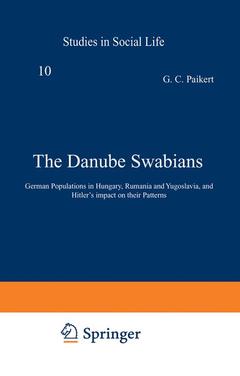Description
The Danube Swabians, Softcover reprint of the original 1st ed. 1967
German Populations in Hungary, Rumania and Yugoslavia, and Hitler’s impact on their Patterns
Studies of Social Life Series, Vol. 10
Author: Paikert G.C.
Language: English
Keywords
18th century; Adolf Hitler; Baruch de Spinoza; Europe; German; Germany; Orient; church; culture; event; idea; media; organization; present; restoration
Publication date: 05-2012
340 p. · 15.6x24.4 cm · Paperback
340 p. · 15.6x24.4 cm · Paperback
Description
/li>Contents
/li>
Sedulo curavi humanas actiones non rid ere , non lugere, neque detestari, sed intelligere. SPINOZA This monograph is an attempt to present some information on the fabric and patterns of an ethnic minority group whose destiny was totally deflected by Hitler and his war. The people in question are the Danube Swabians, German populations who were so called because of their habitat in the middle Danube region of east-central and south-eastern Europe. Research for this study was done in 1964 in Hungary, Yugoslavia, Austria and the Federal Republic of Germany, in which countries the author contacted persons of competence and made use of archives and other sources. He also attended the annual con vention of the Danube Swabians in July, 1964 in VIm, Germany. In fact, he himself had a small part in the events which he at tempts to analyze here. From 1934 until 1944 he served in the Hungarian Ministry of Education in Budapest and headed for some years the department for the schooling of national minorities and also the department in charge of Hungary's cultural inter change. He resigned from the former post in 1939, and was ousted from the second when German troops occupied Hungary in March, 1944. His personal recollections relating to the events during and after his tenure (he left Hungary for England in June, 1946) have been used to some extent in this study, especial ly in Chapter X.
Scope and Objectives.- One Hungary.- I. The early Magyar State — First German immigrations.- II. The 18th century “Great Swabian Migration” — The Austrian military border — Growing differences — Swabian settlements in Hungary.- III. Socio-economic texture of the Swabians in the period before World War II.- IV. Hungarian policies on minorities education, 1868–1944 — Patterns in culture.- V. Relations between state and minorities in the period before Hitler.- VI. Swabian views on the Magyar state idea — Political and organizational texture of the Swabians in the pre-Hitler period.- VII. Relations of the Volksdeutsche with Germany and Austria before the Nazi era — The role of the Deutsches Auslandsinstitut.- VIII. Political and organizational texture of the Swabians from the rise of Hitler to the end of World War II — The course of nazification.- IX. The Swabians and the third Reich — Nazified and “co-ordinated” — Recruited for the Waffen SS.- X. Hungary and Hitler’s Germany — Currents and counter-currents — Hungarian visions and realities.- XI. Wartime territorial gains of Hungary and the Swabians of these areas — Variations on an old theme.- XII. Evacuation and flight.- XIII. The immediate post-World War II period.- XIV. Expulsion — The Swabians in present day Hungary.- XV. Post mortem on the expulsion.- XVI. The “Great Homecoming” — Settlement in West Germany.- Two Rumania.- XVII. A survey of the Danube Swabians in Rumania.- Three Yugoslavia.- XVIII. The Swabian scene before the rise of Hitler.- XIX. The Swabian scene after the rise of Hitler.- Four Summary and conclusions.- XX. Taking stock.- Map.
© 2024 LAVOISIER S.A.S.




